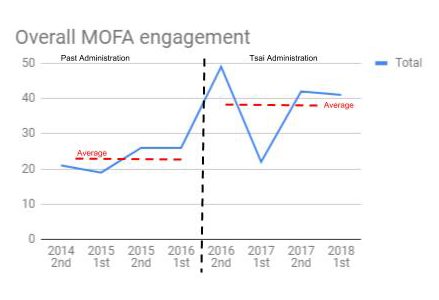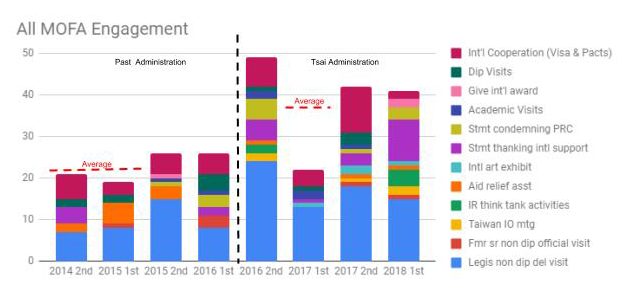When Burkina Faso recently cut official diplomatic relations with Taiwan on May 24 to establish ties with the People’s Republic of China (PRC), President Tsai Ing-wen tweeted: “China’s growing pressure will only strengthen other countries’ support for us.” She added, “[w]e will never back down.” Despite the loss of diplomatic allies, the Tsai Administration has improved the frequency and depth of Taiwan’s international diplomatic engagements. A preliminary assessment of Taiwan’s Ministry of Foreign Affairs’ (MOFA) public news releases show that since Tsai took office starting in May 2016, MOFA has dramatically raised the tempo of its diplomatic activities by over 60 percent. While the international news cycle has overwhelmingly focused on Taiwan’s dwindling number of diplomatic allies, China’s ‘checkbook diplomacy’ and cross-Strait freeze have shifted Taiwan’s attention and effort away from cross-Strait priorities and toward building stronger relations with other countries.
Increase in MOFA engagement across the board
A broader view of Taiwan’s international engagement shows that the tempo of Taiwan’s diplomatic activities with the rest of the world has increased dramatically under the Tsai Administration compared to her predecessor [1]. The charts below in Figure 1 and Figure 2 show all MOFA engagements based on the government’s publicly available news releases. The analysis shows that the previous administration (2008-2016) held around 46 foreign ministry engagements per year (which is 23 per half-year of my unit of analysis in the chart) in its last two years in office [2]. An engagement is defined as receiving a state visit/ foreign legislative delegation/ think tank visit to Taiwan, holding a cultural exhibition to draw international visitors, sending aid to help with foreign disasters, thanking others for helping Taiwan, etc. But the Tsai Administration has increased the diplomatic operations tempo to around 76 engagements per year (which is 38 per half-year of my unit of analysis in the chart). This also equals to around three to four engagements per month under the past administration, yet six to seven engagements per month under the current Tsai Administration.
Figure 1: Taiwan’s total international engagement compared to the past administration.
Though three of the four time periods average above 40 engagements per half year during the Tsai Administration, there is one unusual point in the first half of 2017 where the engagement was much lower. An organization’s set of standard processes and patterns of organizational behavior—technically known as “organizational process”– explains the low 2017 numbers. Taiwan’s government functions typically slow down in the January-February-March time frame due to the Lunar New Year, which is akin to the Christmas time frame in Western countries. The parallel is how Western governments that celebrate Christmas will typically expect slower business operations in the November-December holiday season time frame while Asian governments maintain a steady operations tempo at the end of the calendar year. Slower organizational process during the Lunar New Year also explains how diplomatic engagement dipped slightly in the first half of 2015. Essentially, a dip in government activity at the beginning of the calendar year should be expected in Asian societies.
If the Lunar New Year correlates with slower government organizational process, then according to Figure 1, why did Taiwan’s diplomatic efforts in the first half of 2018 still operate at a high level? A careful look at MOFA data shows that much of the diplomatic efforts are simple and non-laborious tasks, such as thanking other countries for supporting Taiwan’s participation in the World Health Organization, or official statements thanking others for their condolences following the Hualian earthquake in Taiwan in early 2018. Figure 2 below backs up this explanation, since the purple column of “statement thanking international support” was particularly high in early 2018. To be sure, there were still a significant number of foreign legislative visits to Taiwan, such as a French Parliamentary delegation led by Senator Maurey on March 6, and a group of Swedish Parliamentarians who visited Taiwan on April 10. Nonetheless, the overall diplomatic engagement would have been lower in early 2018 without statements thanking international support.
Figure 2: Taiwan’s wide range of international engagement across categories.
More old and new types of diplomatic initiatives
Under the Tsai Administration, MOFA has added new academic and cultural exchanges mostly with the United States and Europe, but also with other parts of the world. Deepening international cooperation with foreign think tanks is a new phenomenon compared to the final two years of the past administration. Think tank cooperation was especially prominent in late 2016 and early 2018. In addition, there has been a greater emphasis on international art exhibits, which constitutes a new phenomenon when compared to the previous administration, particularly in late 2016 through early 2018.
The data in Figure 2 also show how Taiwan is doubling down on past efforts such as legislative visits, loosening travel restrictions, and forming trade agreements. Foreign legislative visits to Taiwan is the foundation and bulk of Taiwan’s diplomatic efforts, and the Tsai Administration has increased these by over 80 percent compared to the past. It is easier for senators and congressmen from the United States and other liberal democracies to visit Taiwan as members of the legislative branch. Due to separation of powers, the legislators are free to formulate their own individual policies and opinions of international affairs and it is, therefore, a simpler matter for them to make visits to Taiwan than members of the executive branch of government. There has also been a jump in international cooperation through visa-waivers and trade pacts compared to the past.
While the international news cycle has widely covered how Taiwan is receding in its formal diplomatic alliances, what is less publicized is that Taiwan’s MOFA is carrying out new initiatives along with greater frequency and depth of old initiatives. As mentioned earlier, the Tsai Administration has increased the frequency of diplomatic engagement by over 60 percent compared to her predecessors. Under her leadership, MOFA has added new initiatives such as international think tank engagement and cultural activities such as art exhibits. It has also dramatically increased pre-existing engagement, especially in visits to Taiwan by foreign lawmakers, and increasing the number of visa waivers and trade pacts. These are the myriad ways that the new administration is working on and looking beyond traditional diplomatic alliances to increase Taiwan’s engagement with the world.
My upcoming Global Taiwan Brief article will more deeply analyze the specifics of MOFA’s top areas of engagement in legislative delegation visits, issuing official statements thanking other countries for their support of Taiwan, and new areas of cooperation such as visa-waivers and trade pacts. I will also more deeply parse the moderate areas of engagement in international think tank exchanges, art exhibitions, and academic visits of foreign scholars to Taiwan.
The main point: Although Taiwan is gradually losing its formal diplomatic allies, Taiwan’s Ministry of Foreign Affairs (MOFA) under the Tsai Administration has significantly increased its other areas of international diplomatic engagement, especially in foreign legislature visits to Taiwan, visa-waiver programs, trade pacts, think tank exchanges, and cultural exhibitions.
[1] There are many caveats to this preliminary analysis for a short Global Taiwan Brief article rather than a lengthy and thorough occasional report. I am analyzing data that are self-reported by Taiwan MOFA. Therefore, the data do not capture all engagement that occurred, only all of the engagement listed on the MOFA website. Taiwan’s MOFA could choose to publicize certain exchanges and not others. There is also a possibility that the previous administration also had abundant exchanges, but that they were kept quiet for diplomatic and political sensitivity reasons. Future research could cull additional sources such as newspapers, think tank reports, and conduct interviews for a more complete picture of MOFA engagement across administrations. Additional research could also reach back further than the past four years to take a longer-term view. Despite the limitations in time and scope of data sources, the data nonetheless paint a useful portrait of the broad trends in Taiwan’s old and new diplomatic engagement.
[2] Explanation of data analysis techniques: (1) One Taiwan MOFA news announcement counts as one individual engagement. (2) I intentionally used half-years as my unit of analysis because visualizing monthly data would be too granular, yet visualizing annual data would miss the nuances. For instance, a half-year works well because President Tsai was inaugurated in May 2016, so the first-half of 2016 was the previous administration, while the second-half of 2016 was the new Tsai Administration. (3) I also took the two years of the Tsai Administration since it is the entire time she has been in office, and matched it against the last two years of the Ma Administration to preserve symmetry in the data between the two administrations over the past four years.






